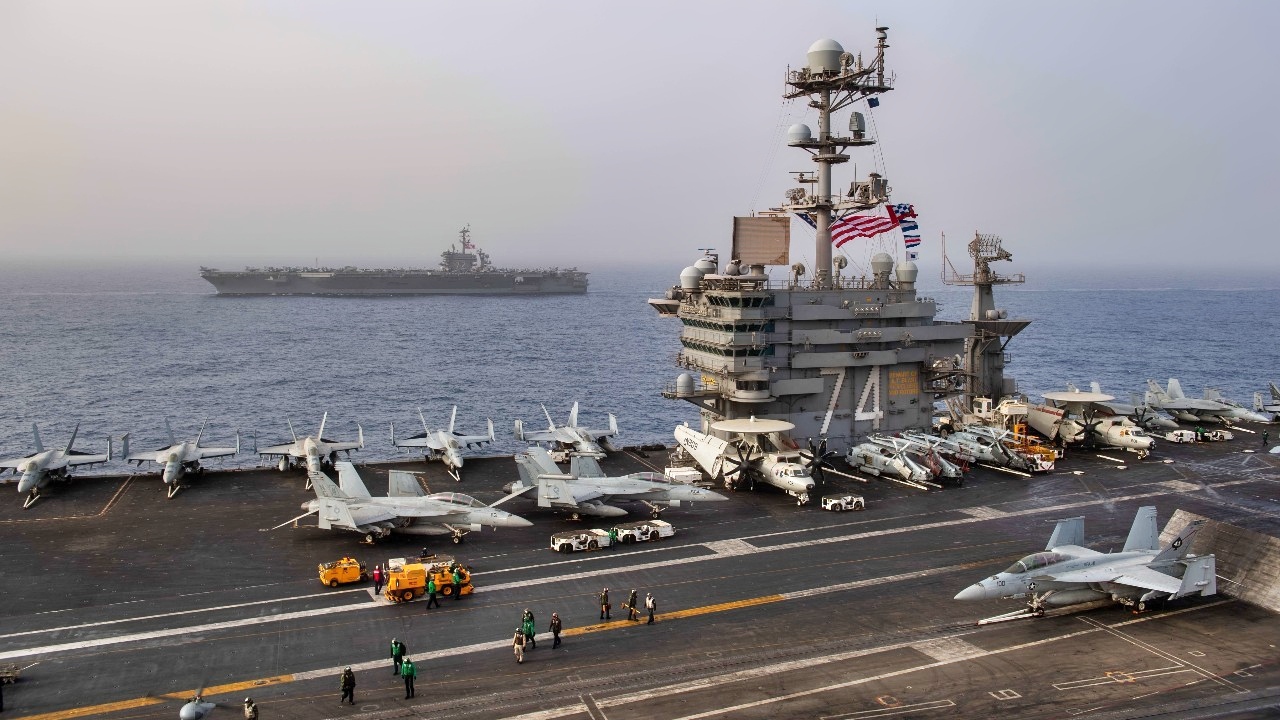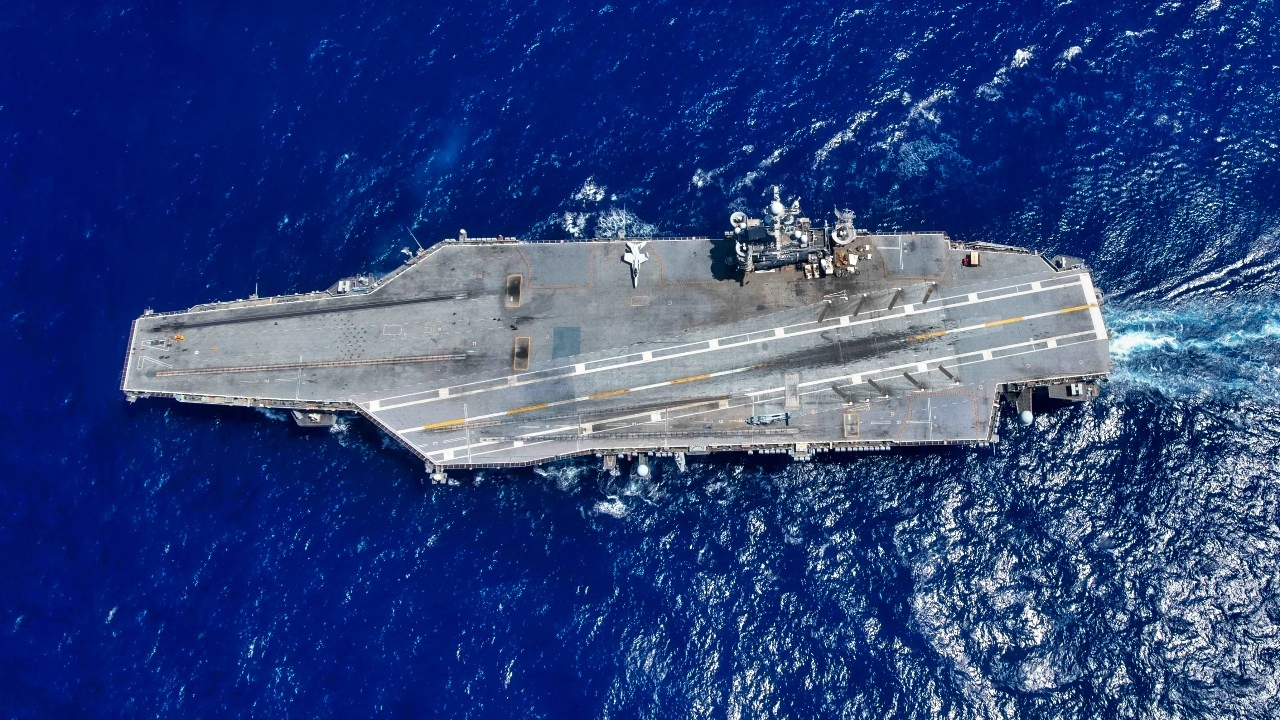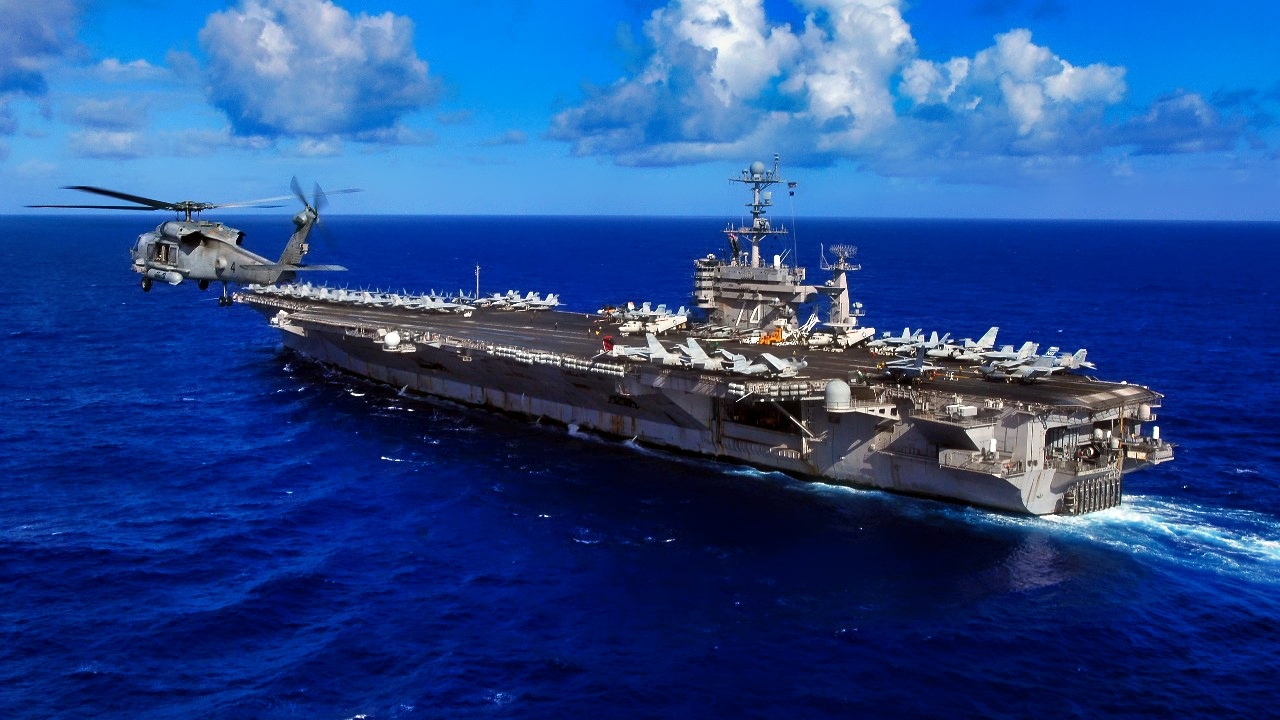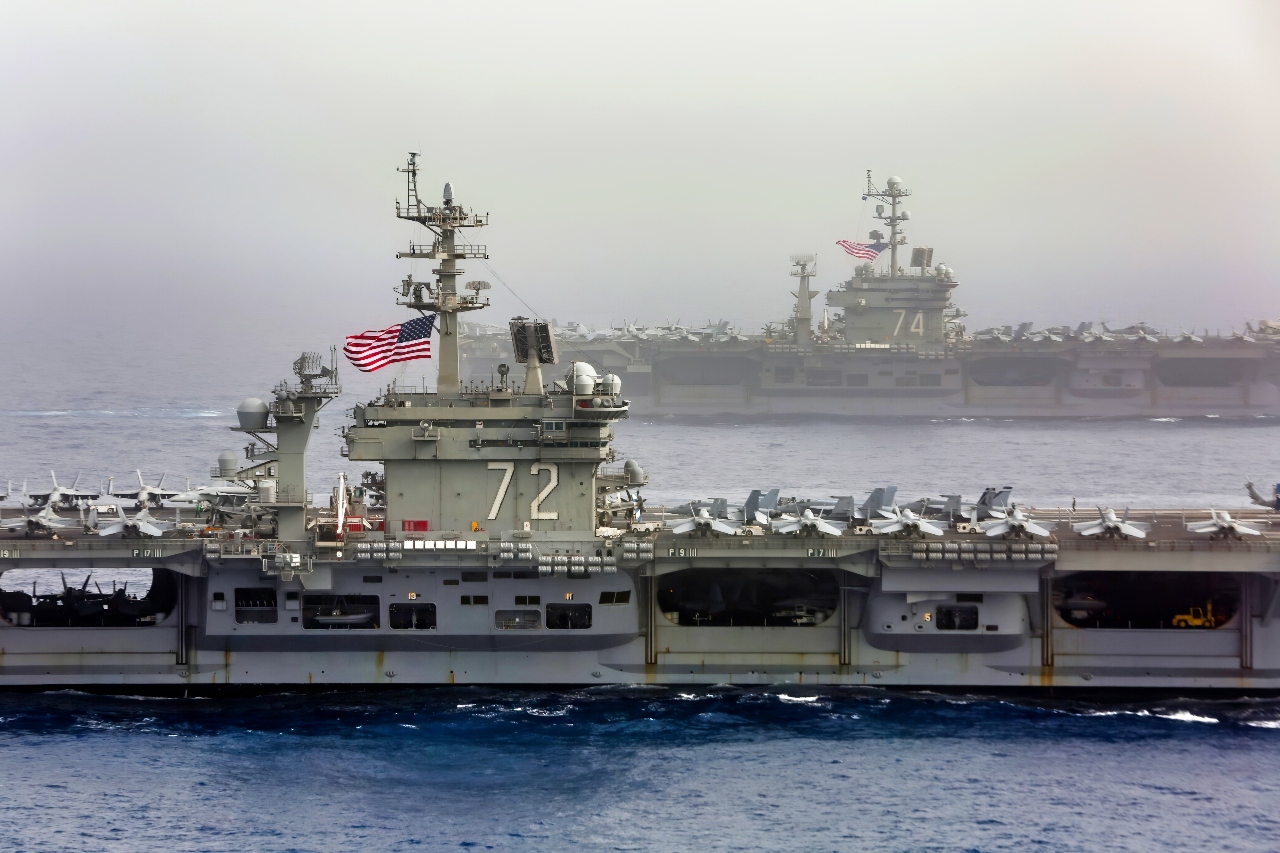Key Points and Summary – USS John C. Stennis (CVN-74) is a Nimitz-class supercarrier commissioned in 1995 and now undergoing a Refueling and Complex Overhaul before returning to Bremerton.
-Stretching 1,092 feet and powered by twin A4W reactors, Stennis exceeds 30 knots, carries 85–90 aircraft, and operates a suite of air-search, fire-control, and EW systems alongside Sea Sparrow, RAM, and Phalanx defenses.

The aircraft carrier USS Abraham Lincoln (CVN 72), back, steams alongside the aircraft carrier USS John C. Stennis (CVN 74) in the Mediterranean Sea, April 24, 2019. The John C. Stennis Carrier Strike Group (CSG) 3 and Abraham Lincoln Carrier Strike Group (CSG) 12 are conducting dual carrier operations, providing opportunity for two strike groups to work together alongside key allies and partners in the U.S. 6th Fleet area of operations. John C. Stennis is underway in the Mediterranean Sea as part of the John C. Stennis Carrier Strike Group (JCSCSG) deployment in support of maritime security cooperation efforts in the U.S. 6th Fleet area of responsibility. (U.S. Navy photo by Mass Communication Specialist 3rd Class Grant G. Grady)
-The ship’s history spans a 1999 grounding, post-9/11 deployments, dual-carrier Gulf operations in 2007, and the final C2 mission over Iraq in 2011.
-RCOH (through early 2026) restores nuclear fuel, modernizes sensors and combat systems, and resets the carrier for decades of service.
Aircraft Carrier Profile, USS John C. Stennis, CVN-74
The USS John C. Stennis (CVN-74) is named for Senator John C. Stennis of Mississippi and is the seventh of the Nimitz-class of nuclear-powered supercarriers in the United States Navy.
She was commissioned on December 9, 1995. Her temporary home port is Norfolk, Virginia, for her scheduled refueling and complex overhaul (RCOH), which began in 2019.
After her overhaul is completed sometime in the 2020s, she is expected to return to Bremerton, Washington.
The Stennis is 1,092 feet long and soars some 20 stories above the waterline.

(Feb. 25, 2019) The aircraft carrier USS John C. Stennis (CVN 74) transits the South China Sea at sunset, Feb. 25, 2019. The John C. Stennis Carrier Strike Group is deployed to the U.S. 7th Fleet area of operations in support of security and stability in the Indo-Pacific region. (U.S. Navy photo by Mass Communication Specialist 1st Class Ryan D. McLearnon/Released)

The aircraft carrier USS John C. Stennis (CVN 74), steams through the Atlantic Ocean, Sept. 7, 2019. The John C. Stennis is underway following a sortie due to Hurricane Dorian earlier this week. Commander, Navy Region Mid-Atlantic ordered all U.S. Navy installations in Hampton Roads to return to normal operations on Sept. 6, as Dorian no longer poses a threat to the area. (U.S. Navy photo by Mass Communication Specialist Seaman Jarrod A. Schad)
As a self-contained city, the Stennis has virtually the same amenities as any American city with a comparable population. It features a daily newspaper, radio and television stations, a fire department, a library, a hospital, a general store, a laundry, two barbershops, and even a post office with its own Zip Code.
The carrier is powered by two Westinghouse A4W nuclear reactors (HEU 93.5%), four steam turbines, and four propeller shafts, each with five blades. This system produces 260,000 shp (190 MW)
The top speed of the Stennis is 30 knots (35 mph) or higher, and she has an unlimited range until her nuclear fuel rods need to be replaced, which occurs every 20–25 years. The carrier is crewed by 6,500 officers and crew (with embarked airwing).
Sensors and Processors
The Stennis has an enormous number of sensors to protect the ship.AN/SPS-48E 3-D air search radar, AN/SPS-49(V)5 2-D air search radar, AN/SPQ-9B target acquisition radar, AN/SPN-46 air traffic control radars, AN/SPN-43C air traffic control radar, AN/SPN-41 landing aid radars, 4 × Mk 91 NSSM guidance systems, 4 × Mk 95 radars
Electronic warfare & decoys include the AN/SLQ-32A(V)4 countermeasures suite, and the SLQ-25A Nixie torpedo.
Stennis Armament
The carrier is armed with four Mk 57 Mod3 Sea Sparrow Missile launchers, two RIM-116 Rolling Airframe Missile launchers, and three Phalanx CIWS anti-aircraft systems.
The USS John C. Stennis is capable of carrying approximately 85 to 90 fixed-wing aircraft and helicopters. However, the exact number can vary depending on the specific air wing and mission requirements.

An HH-60H Seahawk, from the “Eightballers” of Helicopter Anti-Submarine Squadron (HS) 8, flies past Nimitz-class aircraft carrier USS John C. Stennis (CVN 74) during flight operations. Stennis is on a scheduled deployment to promote peace, regional cooperation and stability.

The French Marine Nationale aircraft carrier FS Charles De Gaulle (R91), and the aircraft carrier USS John C. Stennis (CVN 74) are underway in formation in the Red Sea, April 15, 2019. The John C. Stennis Carrier Strike Group is deployed to the U.S. 5th Fleet area of operations in support of naval operations to ensure maritime stability and security in the Central Region, connecting the Mediterranean and the Pacific through the western Indian Ocean and three strategic choke points. (U.S. Navy photo by Mass Communication Specialist Seaman Joshua L. Leonard)
USS John C. Stennis (CVN-74) History
In 1999, the Stennis ran aground in a shallow area adjacent to the turning basin near North Island in San Diego Harbor.
Silt clogged the intake pipes to the steam condensing systems for the nuclear reactor plants, causing the carrier’s two nuclear reactors to be shut down (one reactor by crew, the other automatically) for a period of 45 minutes.
She was towed back to her pier for maintenance and observation for the next two days.
The cleanup cost was about $2 million.
In the early spring of 2001, the Stennis was the site of a world premiere film, “Pearl Harbor,” which was billed as “the world’s largest and most expensive outdoor theater.”
Special, enormous screens were erected on the flight deck, along with special seating bleachers that accommodated 2,000 people.
Post 9/11 Deployment
After the terrorist attacks in the United States during 9/11, the Stennis deployed to the Persian Gulf in November 2001, in support of air operations during Operation Enduring Freedom.
In mid-January 2007, the Stennis’ carrier strike group set sail for the Persian Gulf as part of an increase in US military presence. She arrived in the area in mid-February, joining USS Dwight D. Eisenhower in the United States Fifth Fleet area of operations.

PHILIPPINE SEA(Feb. 22, 2016) USS John C. Stennis (CVN 74) sails through the Philippine Sea. Providing a ready force supporting security and stability in the Indo-Asia-Pacific region, Stennis is operating as part of the Great Green Fleet on a regularly scheduled 7th Fleet deployment. (U.S. Navy photo by Mass Communication Specialist Seaman Cole C. Pielop/Released) .
This marked the first time since 2003 that two aircraft carrier battle groups were present in the region simultaneously.
Later, on May 23, 2007, the Stennis, along with eight other warships, including the aircraft carrier Nimitz and amphibious assault ship Bonhomme Richard, passed through the Strait of Hormuz. US Navy officials said it was the largest such move since 2003.
In December 2011, the Stennis flew the final command-and-control mission for US forces over Iraq, which was conducted by an E-2C Hawkeye from Carrier Airborne Early Warning Squadron 112 (VAW-112).
The mission launched from the carrier at 7:32 a.m. and returned at 11:04 a.m., both local times. This mission effectively ended US naval support for Operation New Dawn.
In early May 2021, the USS John C. Stennis went into Newport News for her midlife Refuel and Complex Overhaul (RCOH). The overhaul is expected to be completed by early 2026.
About the Author: Steve Balestrieri
Steve Balestrieri is a National Security Columnist. He served as a US Army Special Forces NCO and Warrant Officer. In addition to writing on defense, he covers the NFL for PatsFans.com and is a member of the Pro Football Writers of America (PFWA). His work was regularly featured in many military publications.
More Military
The F-35A Stealth Fighter Is Also a Stealth Bomber
Mach 2.65 F-111 ‘Aardvark’ Strike Fighter Has a Message for the U.S. Military
Russia’s MiG-29 Fulcrum Fighter Has a Message for NATO
The X-40A Space Plane Has a Message for the U.S. Military
The Mach 6.7 X-15 Space Plane Has a Message for the U.S. Air Force










